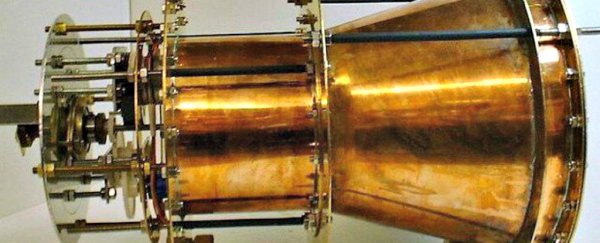After months of speculation and leaked documents, NASA's long-awaited EM Drive paper has finally been peer-reviewed and published. And it shows that the 'impossible' propulsion system really does appear to work.
The NASA Eagleworks Laboratory team even put forward a hypothesis for how the EM Drive could produce thrust – something that seems impossible according to our current understanding of the laws of physics.
In case you've missed the hype, the EM Drive, or Electromagnetic Drive, is a propulsion system first proposed by British inventor Roger Shawyer back in 1999.
Instead of using heavy, inefficient rocket fuel, it bounces microwaves back and forth inside a cone-shaped metal cavity to generate thrust.
According to Shawyer's calculations, the EM Drive could be so efficient that it could power us to Mars in just 70 days.
But, there's a not-small problem with the system. It defies Newton's third law, which states that everything must have an equal and opposite reaction.
According to the law, for a system to produce thrust, it has to push something out the other way. The EM Drive doesn't do this.
Yet in test after test it continues to work. Last year, NASA's Eagleworks Laboratory team got their hands on an EM Drive to try to figure out once and for all what was going on.
And now we finally have those results.
The new peer-reviewed paper is titled "Measurement of Impulsive Thrust from a Closed Radio-Frequency Cavity in Vacuum", and has been published online as an open access 'article in advance' in the American Institute of Aeronautics and Astronautics (AIAA)'s Journal of Propulsion and Power. It'll appear in the December print edition.
It's very similar to the paper that was leaked online earlier this month and, most notably, shows that the drive does indeed produce 1.2 millinewtons per kilowatt of thrust in a vacuum:
"Thrust data from forward, reverse, and null suggested that the system was consistently performing at 1.2 ± 0.1 mN/kW, which was very close to the average impulsive performance measured in air. A number of error sources were considered and discussed."
To put that into perspective, the super-powerful Hall thruster generates force of 60 millinewtons per kilowatt, an order of magnitude more than the EM Drive.
But the Hall thruster requires propellants, and that extra weight could offset the higher thrust, the team concludes.
Light sails on the other hand, which are currently the most popular form of zero-propellant propulsion, only generate force up to 6.67 micronewtons per kilowatt – two orders of magnitude less than NASA's EM Drive, says the paper.
But the team makes it clear that they also weren't attempting to optimise performance in these tests – all they were doing was trying to prove whether or not the drive really works. So it's likely that the EM Drive could get a lot more efficient still.
When it comes to how the drive actually works without messing up the laws of physics, that's a little less clear.
It's not the focus of this paper, but the team does offer a hypothesis:
"[The] supporting physics model used to derive a force based on operating conditions in the test article can be categorised as a nonlocal hidden-variable theory, or pilot-wave theory for short."
Pilot-wave theory is a slightly controversial interpretation of quantum mechanics.
It's pretty complicated stuff, but basically the currently accepted Copenhagen interpretation of quantum mechanics states that particles do not have defined locations until they are observed.
Pilot-wave theory, on the other hand, suggests that particles do have precise positions at all times, but in order for this to be the case, the world must also be strange in other ways – which is why many physicists have dismissed the idea.
But in recent years, the pilot-wave theory has been increasing in popularity, and the NASA team suggests that it could help explain how the EM Drive produces thrust without appearing to propel anything in the other direction.
"If a medium is capable of supporting acoustic oscillations, this means that the internal constituents were capable of interacting and exchanging momentum," the team writes.
"If the vacuum is indeed mutable and degradable as was explored, then it might be possible to do/extract work on/from the vacuum, and thereby be possible to push off of the quantum vacuum and preserve the laws of conservation of energy and conservation of momentum."
Of course, this is just one hypothesis, based on one round of tests. There's a lot more work to be done before we can say for sure whether the EM Drive is really producing thrust – the team notes they that more research is needed to eliminate the possibility that thermal expansion could somehow be skewing the results.
And even once that's confirmed, we'll then need to figure out exactly how the system works.
The scientific community is also notoriously unconvinced about the propulsion system – just yesterday a Motherboard article on the EM Drive was deleted by the moderators of the popular subreddit r/Physics because they "consider the EM Drive to be unscientific".
But is the first peer-reviewed research ever published on the EM Drive, which firmly takes it out of the realm of pseudoscience into a technology that's worth taking skeptically, but seriously.
The next step for the EM Drive is for it to be tested in space, which is scheduled to happen in the coming months, with plans to launch the first EM Drive having been made back in September.
If it produces thrust there, the scientific community will need to sit up and take note. Watch this space.
You can read the full research paper here.
